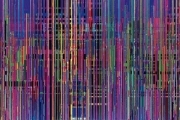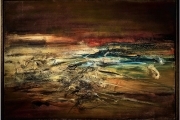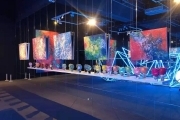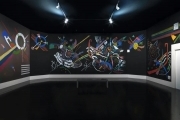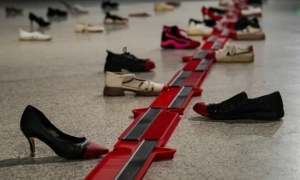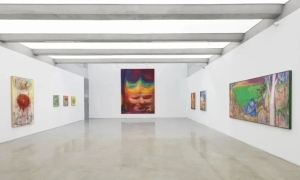对无限的思念
对徐红明来说,艺术是对无限的思念。他首先以手绘,而后以电脑制作作品来表达这种思念。他的作品是这样的视野的果实: 通过创造行动协调了可见的世界和不可见的世界。他的绘画色彩从黑色到灰色,从灰白色直到电脑完美实现的色彩更丰富的调子。这是一种由科技的补形术襄助的创造,这种创造强化了艺术家的精神性和诗学。
徐红明的所有作品揭示出了艺术和艺术家的实践。这一实践不仅仅需要静止的战略,而且包含了整个想象力的领域,艺术家以双重的冲动穿越了这一原野。这种冲动不顾磨难,同时将特权赋予播散和凝聚两种运动。手,头脑和艺术家的整个身体都投入了创造的时刻,这一时刻是一种破除一切障碍的梦幻般偏移,同时始终自如地内接于编织在语言的娴熟和艺术家良知中的风格密码。艺术是一种流溢和尺度的实践,这一实践系统地超越哨位的边界和极限,在它们之外去创造一种不可能性的系统,一种产生自艺术家的姿态的心不在焉的方案——这一方案是一种在自动同时又校准过的图像线条中组织好的混乱运动之果实。
设计性和偶然性同时交织在徐红明的作品里,平衡着艺术的完整性和简约、概要的现实缺陷性。艺术造成晕眩同时又造成认识,让人丧失感觉又通过总的来说颠覆一种单边和经济的交流符号下之社会沟通而使人成长。
在徐红明作品中有一种来自结构模糊性的,支持着图像系统的不同之简洁。这种模糊性避闪了通常语言逻各斯中心主义的傲慢,而靠近一种交叉关系。在这里符号形成了长久一致和瞬间逃亡。如果说爬上艺术家脊梁的冲动是无法控制的,那么可控制的便是使图像力量变得清澈明确的一种必需之手绘娴熟。
语言是一种可以完全提取出的储备,其中只有语言本身防卫和保护的部分是无法提取的。在这里无法与之斗争。艺术家只能组织一种源于内在规则的设计好的松弛。它如同艺术家声明的那样能够复制世界,因为“艺术并不重复可见的事物,而是使事物可见。”艺术家深知自己与语言斗争的失败后,在语言面前以偏斜的立场融于想象洪流,调整自己,收获自己的符号之游牧式移动。
徐红明非常了解语言的本性,从未试图驯服它,而是以包含着设计和选择的想法进程来顺应它。结果完全依靠自由的处置,而剔除了任何期待和先见之明。事实上,并非是艺术家具有先见之明,而是语言在自身之中孵化出图像和异常的结果。艺术家深知,语言有一种基于创造进程的晕眩的积极强暴方式,他也深知,其中构成技巧自动减弱。
。 如果无意识和偶然是丰富作品价值,如果它们还给作品必需的完整性以包含现实的意义,那么徐红明发展了一种能够在艺术制作之中理解由这两个价值表达的不可控制的需求之战略。他通过使用接近东方文化内省的哲学能力的内在方式做到了这一点。
发聋振聩变成了一种胜利。经过艺术家以悖论性技巧控制进行自动和基本的手工制作,作品处于无意美的符号之下。无意性在于松弛的能力,在于感觉冷漠的紧张。这种冷漠的紧张支持着艺术家,使他能够不提前造成一些结果而是能够重新着手去与语言凝聚。一种谨慎的松弛是正确的出发点。
在徐红明作品中不变的恒量是语言的表面主义实践。空间不具有或描述什么深度,而是作为二维的支撑物,丝毫不会沉浸和坠入。这些因素是在艺术工作之前的心理学和想象状态的结果,它们支持着图像的创造过程,而这一过程运用着清澈流畅的语言简洁性。
符号按自然的播散排列,但是并不对表现欲望失去张力。但是表现意味着不自然主义地复制心理的幽暗,也不描述意义的单一位置,而是按浓聚和强烈的不连贯性对符号做直觉处理。语言的可支配体系是那种星群式、放射中心式的。它祛除了等级制度或重力点,祛除了边缘,而是在光环中找到了具象图像与抽象图像联姻的可能性。
在徐红明的作品中色彩进入构成的游戏,增加了来自文化自觉的作品的强度。语言具有自己的内部生物学,有能够产生多重处理的方位沉积。构成作品的纤维状网格沿着开放的缺口在许多交叉和冲撞之上运用着它们的潜力,使作品放射出内部的强烈能量。
在图像中艺术家总是力图再造线性的迷失方向,暗示了内在力量和事物的隐匿性,在平滑外表上留住在隐匿和揭示之间摇摆不定的宇宙的幽灵般厚度。艺术的目光深入事物浓密绿锈和物质的虚假丰饶之下,为穿越所有身体,统治世界的动力蒙上面纱。
东方红 2009年10月 149X452CM
为此不可能走向图像的深度去支持一种在它们滑移和连续性长线间联系事物的流动。这样不时地出现同时捉住事物表面和内部灵魂游移的、抽空的符号之轻盈。物体和形象被还原为悬置和减轻了内部重量的东西,按微微暗示的视觉命名描写出来。
徐红明绝对深知视觉语言的特定本质,深知它的构成因素不可伪作成不同的身份:不过视觉语言的性格可以造成一些存在的共鸣,比如艺术家的观察力和对事物的间距和疏离的当代感受。这样,不可化约的视觉语言的深度之缺乏,它的表面主义的本性变得鲜明,就与艺术家和事物的关联方式、他的对此物及彼物的无选择性生出共鸣。
他并不为事物的感觉外在性吸引而停下来欣赏部分现实。相反他以内在化目光捉住支持事物站立的骨架和它们深处的骨节,使事物在同时的关系体系中还原。这些关系扩展事物的容量,同时证实其易变的本质。
语言也具有了这种易变的性格,成为内在运动和艺术家警觉状态的符号,一种设计好的、不稳定设置的目光的符号。这种目光在事物的内在张力面前产生了昏厥,同时在折磨着事物的外在停滞面前以严厉和封闭的秩序将事物严密操控。艺术在这里变成了自然而然地令人不安的感受的设计。
这样接下来进入主导作品的是一种切断构图的混乱的冲动,把构建好的秩序推向倾覆。这里符号的理不清之结试图构建一处不确定关系的场域,所有这些关系都建立在不稳定性或暂时稳定性之上。有些时候一种符号和色彩的表现主义穿越作品,将其带往一种故意在现实对象面前对称的图像,以确证处于自然主义模仿之外的语言。画家从不去画世界,而是描绘一种忘记这个世界的目光。
在徐红明这里,带有所有痕迹和口误的表现语言以宣言式的偏离的强烈感情占据了优势。语言宣示了技巧控制的不可能性或者证明了带有排除每一种愉悦规则的震惊性控制的可能性。形象和背景错综复杂地融汇在显示感觉过程的关系之中。这一过程由波浪起伏的过痕、回返的路线、交叉、逃逸之点组成。
视觉因素的刻印简约是艺术家感觉状态剔肉留骨的进一步表现,他把自己的目光带到物质魅力和外貌轻而易举的色情主义之外。昆虫学家般观察的细致感觉,支持着与世界的沉思关系,而这一关系由细致和分析的减速与感受和颤动的加速组成。
叙述艺术家内在风景的基础(版画式)刻印永远是病变的结果。这种病变包含细节激化的描述主义和图像带有的各种情势、偶然之微型化。它按照证明世界完整性附注,通过丰富了整个结果的细节激化构建。这是符号的微观世界对宇宙宏观世界不可避免的注释。
如果艺术使可见闪光,这意味着图像是运动的凝结之物,它吸引着符号的旋风和微流,它们使图像富于关系与不确定性。这是由轨道偏离、极细微共鸣和微妙不和谐音组成的不确定性。
非云非雾非霁 149x226_2009年1月3---2月12 布上矿物岩彩粉
刻印笔画的激化自然要求熟练和轻盈,要求决定本质的感受和描述能力。
其它情况下,徐红明的图像是在拟人面具和它的嬗变间摆荡的符号乱结。一种无限、坚不可摧的粗糙雕刻,以无尽、着魔的方式沿着自我运行,就像他在童年时置于大理石桌面上的手不可克制的移动——平面是那样光滑,追寻符号的纠缠交织的欲望是如此强烈。 空间在这里是支撑的条件,用图像成型而最后不指向连续性。
如此发生了形象沿着以内在、向内指向的过程排列的失真线条拥挤在一起。不存在正面观察的方式,因为形象拥挤在绘画或素描的每一点上,使保证传统沉思的方式失效。一种内在的也是喜剧的安静永久统治着构图,,好像目光安静地巡视着一种语言的变质,这种语言自然地走向失真,扭曲和噩梦。
徐红明不惧怕与居住在语言深处的幽灵相遇。图像不取代其它图像,它们是唯一和可表达的。这里它们假作表达重巡面孔和事物熟悉的线条的特点,事实上它们带着纯语言实体的面具,而这些实体具有改编的能力和延续自己内在路程而不偏离的力量。
风景也被驱离它们的静态而不定地降落在二维平面微斜的路上。沿对角线出现了房屋,自然因素和人形。所有这些都是以超低空飞行攫取的,就像一种坠落而奔向事物的目光或坠落而远离事物的目光。一种泛灵论意义隐伏在这些过程中,同时有一种偏离微妙几何的直线性几何:这一几何是自然的内在性,是世界的去物质化的结构。
全面的目光和攫取细节的能力不停地互相渗透。这一渗透不寻求形式的平衡而是跟踪和追寻两种可能性的同时共存。深度和表面具有同样的视觉在场,就好像有一种唯一的力量能够攫取可见和不可见的并把它们带到图像居住的显灵之地。这一地方具有使空间因素同时连续相关的可能性。
一种领域的能量 统治着徐红明的图像并以移动而同时本质的词汇定义着空间。共时性诞生于描述宇宙的愿望,在这个宇宙中空间和时间在所有它们的力点上同时缀合:上下,高低,远近,先后,现在和将来。一种绝对的循环领导着图像,而图像完全包含在一种不仅能预示,而且能将世界的考古,今日和未来同时包含的语言自足参见符号中。
作品在两股平行奔驰同时又这一共存是这岔开的力量牵引下趋向图像的结果,这一结果从不是世界的复制,在它日常状态中分别将秩序和混乱,计划和偶然结合在一起。艺术相反具有共时连接的模糊和斜视的力量,通过当代的悖论的破碎建立图像之核心。
这样,抽象和具象总是能在阐释和离心两种因素的张力之上找到共存。
向心的因素试图组成在叙事亦即具象要求周围建立的参照点,离心因素则运用符号的脱臼和雾化。这些符号沿着穿过叙述编织的交叉轨迹奔涌,将图像带向抽象的结局。这样抽象与具象成为使复合和完整图像还原的表现方式,这一方式由内在的加速(时间)和精细的减速(空间)组成。
在徐红明这里于事物本体之中的下降是物质的干涸的结果,一个在物体或形象的骨架中发生的过程,直到无法辨认轮廓。视点是多重和迷失的,同时是差异化的。有时图像似乎自上方创作,好像以本质同时是极为锐利的目光掠过。这种目光可以击败距离。
对自然形式的注意力试图在其状态中追求统治生命的生死循环力量复杂性。因为死亡也居住在生命中,艺术应该能够在自己的形式系统中使各因素运动和瘫痪以包含两极。现在图像的形式如同艺术家自己在述说的系统,具备了存在的循环中被表达的两极。
生命力的因素来自图像的体系性,来自图像符号的各有机体关系的网络性。瘫痪,停滞和死亡因素则来自局部的叙事停顿。
艺术的形式运载着臣服于重力法则的整体之碎片,通过物件和形象的骨架的减轻自重而得到拯救。这些物件和形象由此获得本质上的轻灵和确定的内涵,这些轻灵和内涵置身于统治人的命运的时间溶解和空间增殖过程之外。
对徐红明来说,艺术应该通过视觉语言的特殊武器面对存在的复杂性,而这种视觉语言适合于汇集必需的风格交汇以表达对世界的感觉性观念。
为此艺术家用风格武装起来,这一风格描述人在静态和动态问题方面的位置,而静态和动态问题恰恰代表了时间和空间的激进。艺术家自然也会在这极端的两极之外活动,开辟出禁止垂直性的线的使用,并走向倾斜和断裂。这一运动也表达了静态因素及它的万神殿对动态可能性的张力。
图像有意的基础性也来源于这样的苛求:永远留在视觉的严格的环境中,留在可以证实创造过程的轨迹的可能性中。以技巧的确切掌握顺从于创造过程,技巧在这里是精神的范畴,而不仅仅是手的灵巧的肤浅知识。构图技巧的解构性精简帮助艺术家避免轻率行动的浪费,同时置身于由冲动组成的手势的直觉自由中。“创造,以少量的手法,创造出精神的丰裕。”这是一个命令式,通向肉身消失,表面自然死亡的姿态,这一姿态能够使精神的丰裕凸显出来,而这种丰裕永远是自由态度的结果。
我们并非在谈论自然的自由哑剧和它原始状态,而是要负起对混乱的预先的责任:在混乱之中按宇宙力量去构建一个关系的体系。在这个体系中开放地共生着细节和宇宙,秩序和无序,微观和宏观。这样艺术家不对自然开战,也不与它融为一体,而是找到能使运用的语言丰产的表现音域。
在这个意义上,徐红明在语言面前作为创世者以在视觉语言的河床中呈现新现实的能力武装起来,这一能力能够使沉积在它的薄膜下的梦幻力库发出新图像之萌芽。创造过程在于挖掘的系统行动,和自然的典型行为相反,而自然的典型行为永远是有机、严格地证明着进化和增殖扩张的原则。
艺术创造的经济学要求一种穿行于直觉和熟练的规则。创造冲动应该找到细节的明智的障碍,应该遭遇形式意志的抵抗。这种抵抗能将冲动化为持续的微风,而这种微风则将它的温度布满图像的所有缺口。
太阳和月亮的气候在作品的肉身消失的热量中不可分割地交叉。作品承担了所有的折衷主义,几何和模糊的符号。艺术家应该能剥去所有的尘世的诱惑,这意味着不去沉溺于符号的纯快感的自恋。真正的快乐是严谨性的快乐,是后续结果的快乐。创造实践是严肃的,在它的理论化中依然从容。这一理论化由对图像的循环世界,符号的宇宙叙述和参与符号组成。符号的宇宙充满了点,线和纯运动。基础性并不来自虚假的原始主义和走向艺术开端的修辞倒退,而是来自对表面的系统剥夺。
在徐红明这里刻印是完美性的孕育,作为道德的苛求,一种艺术家倾向的永恒不满之运动。这一运动将艺术家带向无休止的不断工作,带向持久的研究。这种研究充满许多细致的进攻,而这些进攻不可避免地将他带向“幸福”,带向达到的能力证实。这是艺术幸福论的终点,存在于艺术实践的所有内部,,存在于图像的手工中,同时存在于思想研究的内部。
因为符号是它的历史承载者。它带有一种实质,这种实质只有艺术家能新颖地达到,每一次,或更正确地说,一次一次地达到,而且从来不陷于终极性结果。
艺术的形象表现只有在分清记录可见事物的能力和唤起不可见事物能力时才能达到。这里需要一种努力,一种系统的实践,能将普通感觉无法感到的因素凸显出来。
图像的形成比图像自身重要的多,前者是艺术家在整个创作生涯中不停顿的路程,这是他的生活本身,后者则是单件创作结果,是作品创作面前静态愉快自恋的停留。动力从独创性的理想而来。面对这一理想艺术家应该敢于以此第一能量深入单个部分和整个构成。艺术家应该运用他对作品的创造统治。
这样经验构建价值,在价值之上存在着艺术工作和我们追求的最后价值:运动中的收获将我们带向其它的创造冒险,带向永久质疑以获取的知识的持续努力。
艺术变成现存事物的永恒剥去,以利于进一步通向这样的空间:在起点的不定与实质结果的校准之间奔行。
结果慢慢地出现在艺术家眼前,就像图像的受胎告知(注1),只有这个符号出现,而不是任何其它可能的符号,图像的宣示和显现有实质的和不可分割的实体的恐怖,因为已经分割,分离过,而后,重新在和整体的运动关系上聚为一体。直到这里,通过加速和减速,分析的提示和综合的深入——所有这些奔向闪光的一瞬间——艺术家在工作中持续统治和操控着语言。
闪光在工作的耐心操劳中迸射,奇迹般地在自己的光辉中吸收(艺术家的)努力和努力的记忆,期待与希望。一种加尔文式的热情的邪恶希望。这一热情了解不可或缺的严密以期等待甜美的时刻。在艺术中不存在期望事件的可能性之外的奇迹。
图像的受孕告知静静地、一步步的来到,就像艺术家附着在自己的想象力上控制着的一种缓慢显现:他锚定般地沉浸于心与手的耐心的熟练,心理的自动和图像的创造实践。深刻事物的纬度、视觉语言的纬度和一种符号的连接:通过循环的一道闪电,聚合了时间和空间,以告知艺术的迷宫,在这里生命和毁灭在形式的运动中交汇。
阿基莱-伯尼托-奥力瓦
注1:达-芬奇名画
Nostalgia for the infinite
Xu Hongming sees art as nostalgia for the infinite, por-trayed through a form of painting that is created first by hand and then on the computer. The works are the fruit of a vision which, through the creative act, seeks to reconcile the worlds of the visible and the invisible. The colours of his paintings range from black to gray, from gray-white to chromatically richer tones in forms that the computer accom-plishes with absolute perfection. A creative process with the assistance of this technological prosthesis that en-hances the artist’s spirituality and poetics.
The entire span of Xu Hongming’s work displays the prac-tice of art, of the artist who calls not only for stationary strategies, but also for the full realm of imagination to be involved, traversed as it is by a two-fold urge which hon-ours neither high nor low, and simultaneously favours the movements of dispersion and concentration. Hands and head, the artist’s entire anatomy takes part in the moment of creation, a drifting of fantasy that knows no barriers yet, at the same time, agrees to partake in a distinctive style that is fully embedded in the awareness and mastery of lan-guage. Art is an exercise in breaking through barriers and testing their confines, steadily overflowing boundaries and passing the danger point beyond which a system of impossi-bility can be created, a project of inattentiveness that springs from the artist’s specific attitude, prey to a wave of bewilderment set within the exacting lines of a cali-brated yet automatic image.
Planning and creative randomness together weave through his work, which aims to counterbalance the inadequacy of a schematic and reductive reality with the complexity of art. Art engenders bemusement and, at the same time, knowledge; loss of meaning and also its expansion, by means of a dis-orienting practice that, by definition, tends to upset so-cial communication which is usually signalled by unilateral and economic exchange.
In Xu Hongming’s work, the system of the image is gov-erned by a different economy, fuelled by a structural ambi-guity that bypasses the logocentric presumptuousness of com-mon language, thus reaching an area of interwoven relation-ships, in which signs are arranged along a continuum con-sisting of fleeting chords and fugues. For whereas the im-pulse that winds its way up the artist’s spine is beyond control, one can nonetheless control the manual craftsman-ship needed to render the strength of the image patently clear and explicit.
Language is a reservoir in which one plunges with open arms, with no other provision than that which language it-self inwardly shelters and safeguards. One cannot fight against such provisions: on the contrary, the artist plans an ordered retreat born of inner discipline that is capable, as he himself declares, of duplicating the world, for "art does not reproduce visible things, but rather renders visi-ble". The artist surrenders to the flow of imagination by standing sideways on to language, in a position of conscious loss, ready to welcome the nomadic movement of his signs.
Xu Hongming is fully aware of the nature of language and has never attempted to tame it: if anything, he humours it by using processes that involve the idea of project and choice, but allow the outcome to emerge freely, without ei-ther expectation or foresight. It is not indeed the artist who is prescient, but rather the language which inwardly harbours unusual images and outcomes. The artist is aware of the technique entailed in the active abuse of language, based on the befuddlement of creative processes, the auto-matic dwindling of composition techniques.
If the unconscious and the purely accidental are values that enrich the work, re-establishing that characteristic complexity which is needed to enclose the meaning of reality, then the artist has developed a suitable strategy for understanding the uncontrolled moments expressed in the ar-tistic artefact through those two values, by adopting a lesser degree of discipline, closer to the philosophical ca-pacity for introspection seen in Oriental culture.
Bemusement then wins through, acquiring an elementary and automatic dexterity of hand by means of a paradoxical control of technique that marks the work with an involuntary beauty. This state of involuntariness lies in the ability to surrender, in the tension of emotional indifference which helps artists, enabling them not only to forego prediction of any possible result, but also to yield to the condensing of language. Judicious abandonment is the proper starting place.
A constant aspect in the work of Xu Hongming is the su-perficialistic use of language. The space neither has nor depicts any depth whatsoever, but offers itself up as a two-dimensional support with no hint of hollows or dips. If any-thing, these are the fruit of a psychological and fantasy state which precedes the work of art, movements that favour creation of the image which, in order to come to fruition, uses the economy of a clear and flowing form of language.
The signs are arranged following a natural form of dis-semination which never loses its desire for expression. But expression does not mean merely tracing the darkness of the psyche in a naturalistic way, nor even describing one place as a unit of meaning, but rather instinctively arranging signs according to a dense and intense fragmentariness. The system of arranging language is like that of a constellation, an irradiation centre that knows neither hierarchy nor points of gravity, nor peripheries but, if anything, in its sunburst arrangement discovers the possibility of conjoining figurative and abstract images.
Colour also comes into play in Xu Hongming’s composi-tions, increasing the intensity of a work that also springs from a cultural awareness. The language has its own internal biology, an orientation of sediments that enables manifold arrangements. An intense inner energy radiates from the work, which is built up by using wispy lattices that distribute its potential along pathways amenable to countless crossroads and collisions.
In his pictures, the artist always seeks to recreate a form of linear disorientation, enabling reference to the in-ner and occult strengths of things: a board which, within its smoothened surface, holds the ghostly thickness of a universe poised between revelation and concealment. The penetrating eye of art peers beneath the dense sheen of things, below the false opulence of matter, to cloak the es-sence of an energy flow that moves through all bodies and governs the dynamism of the world.
This is why depth cannot be given to the image - to fa-vour the surge that links things together along continuous and flowing lines. And then, the buoyancy of a wandering and emptied sign sometimes appears, which simultaneously brings together the surface skin and the inner soul of things. Ob-jects and shapes reappear as though suspended and relieved of their inner weight, portrayed by means of a visual naming that is but barely implied.
Xu Hongming is fully aware of the specific nature of visual language, of its constituent elements which cannot feign a different identity: if anything, the nature of vis-ual language allows some existential consonances to be for-mulated, such as the artist’s spirit of observation and his simultaneous sense of detachment and non-attachment to things. Hence the relentless lack of depth in his visual language: its superficialistic nature is brought to the fore in harmony with the kind of relationship that the artist has with things, his lack of preference for one object over an-other.
He is not attracted by the sensual outward appearance of things: this would lead him to feel occasional attraction towards some real situations whereas he tends to apply an internalized gaze, capable of recognising the framework which holds them together, and their deep skeletal structure; and then he puts them back into a system of simultaneous relationships which amplifies their scope and, at the same time, affirms their fluctuating nature.
His language also assumes the traits of this fluctuation, a sign of the author’s inner mobility and also his state of alarm: a planned yet precarious order in the way of observing, befuddled before both the internal tension of things and the external paralysis that grips them, regiment-ing them into rigid and closed ranks. Art becomes the plan-ning of a naturally alarmed sensitivity.
At this point, the urge for disorder takes over the work, disrupting its composition, thrusting it towards a reversal of established order. An inextricable jumble of signs spreads out to establish a field of fleeting relationships, all resting on instability, or on the stability of a moment. Sometimes a signed and coloured expressionism moves through the work, guiding it towards an image that is deliberately incapable of symmetrically yielding before its real-life models, thus confirming that this language stands outside the mere copying of nature. The painter never paints the world, but rather observes it so as then to forget it.
In Xu Hongming’s work, there is an overriding use of the language of expression with all its hints and lapses, its deviant and even declared drive. A language which proclaims the impossibility of technical control, or affirms the pos-sibility of a dazed control, with a form of discipline that excludes all complacency. The figure and the background in-terpenetrate inextricably in a relationship that enables trails of sensitivity to be identified, consisting of undu-lating passages and reversions, intersections and vanishing points.
The elementary graphic signs which shore up the descrip-tion of his inner landscapes are always the outcome of an alteration, comprising both an exaggerated descriptivism of details and a miniaturisation of the varying incidents and circumstances that accompany the image. An image which is built up through an overstatement of details that enhances the effect of the whole by using references that affirm the complexity of the world, a microcosm of signs that inevita-bly recall the macrocosm of the universe.
The graphic reduction of visual elements is a further sign of the artist’s sensitive state being stripped to the bone, of his ability to direct his eyes beyond the fascina-tion for matter, beyond the simple eroticism of appearances. A meticulous sense of observation, like that of an entomolo-gist, aids his contemplative relationship with the world: a relationship consisting of painstaking and analytical slow-ing down, as well as heartfelt and pulsating acceleration. If art makes the visible clear, this means that the image is the place for a mobile curdling, which attracts light winds and whirls of signs that cause it to teem with relations and uncertainty: an uncertainty consisting of sliding trajecto-ries, wispy consonances and subtle dissonances.
Exasperating the graphic stroke naturally requires skil-fulness and lightness of hand, awareness of essential defi-nition as well as descriptive ability.
On other occasions, Xu Hongming’s image is a tangle of signs which swing between the anthropomorphic mask and its transformation into something else. A never-ending and elu-sive graffito, which runs endlessly and obsessively in its own track, as though it were on a marble table, that of his childhood, where the hand is unable to stop itself sliding over the smooth surface, giving in to the temptation of tracing its interwoven latticework of signs. Space serves as a system of support which is embodied in the image, without any break.
So now the figures are crammed side by side, following anamorphic lines that pursue an inner and introverted path. There is no place for frontal observation, since the figures crowd all points of the painting or drawing, without any kind of arrangement that might favour more orthodox contem-plation. An inner, even comical, calm always governs the composition, as though the eye were tranquilly absorbing the alterations of a language that is quite naturally inclined towards anamorphosis, distortion and nightmare.
Xu Hongming does not fear meeting the ghost that dwells within language, in its very depths. The images do not sub-stitute other images, they are the only ones that are possi-ble and portrayable. Sometimes, they pretend to breathe life into characters which hark back to the familiar features of a face or object, but in reality they are assuming the mask of entities that are purely linguistic, and in fact have that same ability to adapt, and the strength of recalling nothing other than their own inner path.
Even the landscapes rush down the slopes of the two-dimensional surface, pivoting beyond their static equilib-rium, along diagonals that welcome houses, natural elements and human figures. Everything is pictured at a low level, as though observed while plunging headlong towards things, or hastening far away from them. A feeling of animism lurks in these passages and a straightforwardness that delineates subtle geometric forms: geometry is the innermost state of nature, the dematerialized structure of the world.
An all-embracing eye and the ability to grasp detail ceaselessly intermingle, in an osmosis that seeks no formal balance, but tracks and pursues the simultaneous co-presence of both possibilities. Depth and surface have the same vis-ual presence, as though one single force were able to grasp the visible and the invisible, and take them to the place where epiphanic revelation is experienced, where the image dwells. A place which can, at one and the same time, main-tain a constant relationship between spatial elements.
Xu Hongming‘s images are sustained by an energy field that defines spatiality in both mobile and essential terms. This simultaneousness is born of the desire to describe a universe in which space and time are dimensions that are contemporarily conjoined in all their potential, that are the above and below, the high and low, the near and far, the before and after, the present and the imminent. An absolute circularity thus governs the image, which is fully absorbed in the self-sufficient indications of a language capable not only of anticipating, but also creating forms of coexistence that inwardly contain archaeology, the present and the fu-ture of the world.
This coexistence is the outcome of a creative strategy that is able to declare the mysteries of technique and, at the same time, entrust to the sudden but ungovernable im-pulses of the hand. An open dualism sustains the work, al-ways ready to strive after deliberate disorientation through skilfulness, thus linked to memory, and calculated improvi-sation which, instead, requires a gamble.
The work is under tension from two forces that run par-allel to, yet simultaneously diverge from, the outcome of the image, which is never a duplication of the world, tend-ing in its daily life to separately conjugate order and dis-order, design and randomness. Art, however, has the ambigu-ous and slanting force of a simultaneous conjugation that creates the nucleus of its image by means of a contemporane-ous and paradoxical fragmentation. Yet abstract and figura-tive always manage to find coexistence, based precisely on the tension between these two elements, the non-nucleant and the centrifugal.
The centripetal element tends to establish reference points placed around a narrative, and therefore figurative, need. The centrifugal element uses the disarticulation and atomization of signs, which run along entwined trajectories that pass through the narrative fabric and lead the image towards abstract results. So abstract and figurative are means of expression that aim to restore a complex and com-plete image, consisting of internal acceleration (time) and painstaking slowing down (space).
In Xu Hongming’s work, the descent into the substance of things is the result of a drying up of matter, a pathway into the skeleton of the object or figure, to the point where the contours can no longer be seen. The viewpoints are various, disorienting and, at the same time, differentiated. Sometimes the image seems to be taken from above, as though gently skimmed by an essential yet extremely intense eye which can, in other words, overcome distance.
On other occasions, the viewing point seems to emerge from inside the very image, perforating it and then moving towards the outside. But in all cases, transparency and opacity are qualities of the image.
By emphasising natural forms, he aims to trace the com-plexity of forces that govern the life and death cycle of existence through the phenomena of nature. Because even death inhabits life, and art must be able to contain both polarities within itself, with an arrangement of form capa-ble of rendering the movement and paralysis of elements. Now the form of the image, like the collection of which the art-ist himself speaks, holds both polarities expressed in the cycle of existence.
The crucial element lies in how capable the image is of offering itself as a system, as a network of relationships between various organisms of signs. The element of paralysis, stagnation, death lies in the descriptive suspension of de-tail.
The art form diffuses fragments of a whole that is sub-jected to the laws of gravity, which fights back by making the skeleton of objects and figures lighter, so that they attain essential weightlessness and also definitive connota-tion, unaffected by the processes of temporal dissolution and spatial proliferation that govern the destiny of human-ity.
Xu Hongming believes that art must deal with the com-plexity of existence by using the specific weapons of visual language, which can be fittingly applied to finding the nec-essary stylistic plots for implementing a sensitive idea of the world.
To do this, the artist girds himself with a style that illustrates the position of humankind with regard to the problems of static equilibrium and dynamics, which typify the radicalization of time and space. Naturally, the artist also moves outside these extreme polarities, embracing the use of lines that rule out the vertical, so as to arrive at slanting and splintering. This mode of movement also ex-presses the pathos of the static element, its straining to-wards the dynamic possibility.
The deliberate elementariness of the image also stems from the need to remain constantly within the strict con-fines of the visible, within the realm of possibility that enables continual verification of the stages involved in the creative process, bolstering it with the confidence gained from technique. Technique in this case is also spiritual discipline and not mere notional awareness of manual dexter-ity. The destructuring dwindling of his composition tech-niques helps the artist to avoid the wastefulness of rash acts and, at the same time, to indulge in the instinctive freedom of impulsively devised gestures. The imperative is "To create spiritual abundance, with very little,” leading to an attitude of de-fleshing, of naturally mortifying ap-pearances, enabling the emergence of that spiritual abun-dance which is always the result of free behaviour.
This does not however mean mimicking the freedom of na-ture, in its wild state, but rather adopting the foresighted capability of chaos to structure itself according to a cos-mic potential, a system of relations in which the particular and the universal, order and disorder, microcosm and macro-cosm openly coexist. The artist does not, therefore, fight against nature, nor seek to integrate with it, but rather tries to find an expressive register capable of making the language he uses fruitful.
In this sense, Xu Hongming sets himself demiurgically before language, armed with the ability to prompt new reali-ties in the riverbed of visual language, and cause new im-ages to sprout in the sediment of fantastic energy deposited under its veil. The creative process consists of systemati-cally digging out, in direct contrast to the typical activ-ity of nature, which always puts in place, a lush and or-ganic growth that affirms the principle of development and proliferating dilation.
The economy of artistic creativity requires discipline, blended with both instinct and skill. The creative impulse must seek to stumble on the wisdom of detail, it must face the resistance of formal will, enabling the motive force to be transformed into a continual breath that spreads its warmth along all the pathways of the image.
Solar and lunar atmosphere insolubly entwine in the fleshless heat of the work, which undergoes every kind of eclecticism, geometry and nebulous sign. The artist must be able to divest himself of all worldly temptation, in the sense that he must not be so narcissistic as to yield to the pure pleasure of the sign. The true pleasure is that of firmness, of the result that has been achieved. Creative practice is harsh, though also casual in its theorisation, consisting of description and references to the circular world of the image and its universe of signs, consisting of points, lines and pure movement. The state of elementariness does not stem from a false primitivism, a rhetorical regres-sion towards the dawn of art, but rather from the systematic stripping of appearances.
In Xu Hongming’s work, the graphic style burgeons with perfection, in the sense of moral rigour, the artist’s abil-ity to stretch towards a movement of everlasting dissatis-faction, which causes him to work intensely and without pause, to elaborate constantly by means of painstaking on-slaughts that inevitably lead to "happiness", to recognition of an acquired skill. This is the eudaimonistic aim of art, all caught up within its own practice, the crafted and si-multaneously mental elaboration of the image.
For the sign bears its own history, of an essentiality that only the artist can once more attain, each time - in-deed time after time - without ever being able to cede to a definitive result.
Artistic figuration can be achieved only through a clear understanding of the difference between the ability to see visible things and the skill involved in bringing out the invisible.
In this second case, an effort is required, systematic application capable of bringing to the fore details which exist beyond common perception.
Formation of the image is much more important than form itself, since the former denotes a continuous pathway along which the artist moves for the entire span of his work, which is indeed his very life; whereas the latter denotes the single result, the pause in a static narcissism which complacently observes the created work. The urge starts from an ideal originality to which artists must adhere if they are to suffuse the individual parts and the whole of the composition with this primary energy. The artist must exer-cise his creative rule over the work.
Experience is thus the value upon which the work of art rests, and also the ultimate value to be attained, a mobile acquisition that drives one towards other creative ventures, towards unceasing practice that always brings the acquired facts into question.
Art becomes a perpetual stripping of what already exists, in favour of a further step into a dimension that ranges be-tween the uncertainty of the beginning and the fine-tuning of an essential outcome.
The result appears slowly before the artist’s very eyes like an Annunciation Image, the appearance of that sign and no other, revelation and epiphany of an image that has the awfulness of essence, of substance that is indivisible, since it is by now already divided, separated, and at last reunified in a mobile relationship with the whole. Until this moment, the working artist continues to govern and ma-noeuvre the language, by accelerating and decelerating, ana-lytical insights and cursory lunges, which as a whole are capable of aspiring to that dazzling moment.
The lightning bolt strikes as a result of the patient blows of application and miraculously absorbs into its blaze effort and the memory of effort, expectation and hope. Hope pervaded by Calvinistic passion, fully aware of the vital rigour needed to reach the moment of grace. In art, there are no miracles other than the possibility of deserving the desired event.
Annunciation of the image thus occurs silently and gradually, like a slow unfolding governed by the artist’s devotion to his own imagination: he yields to psychic automation, to the creative exercising of the image, with a movement rooted in the patient skill of his hand and mind. The story lines existing in the depths find correspondence in the texture of visual language and come to fruition in a Sign: a flash of lightning streaks across the sky, condensing Space and Time, and proclaims the labyrinth of art, where life and death entwine in the movement of form.
Achille Bonito Oliva
【编辑:袁霆轩】



